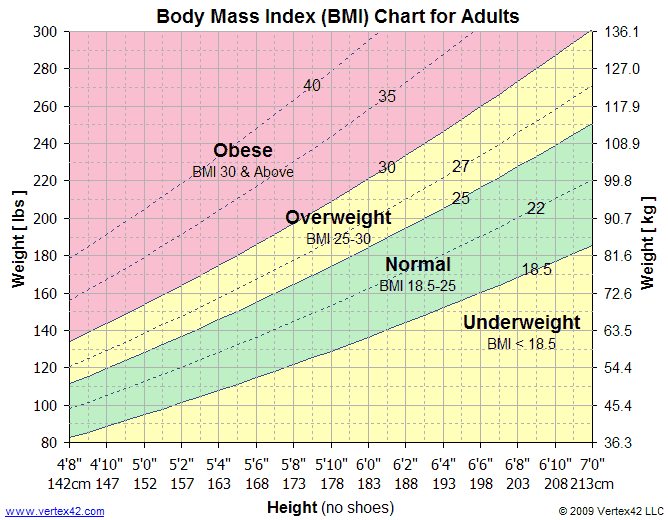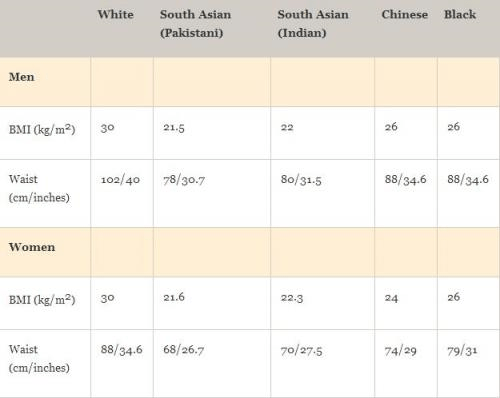Focusing too much on numbers can be a hindrance, especially because everybody is different and lives under different circumstances. However, numbers can help us figure out where we are at when it comes to fitness and health. Your focus should be to feel good and be healthy. Don’t focus on reaching a certain number, like weight or daily calories. Instead, use these numbers to help gauge your progress, as well as a learning tool.
Body Mass Index (BMI) Ideal Weight, Estimated Body Fat and Lean Mass
The Body Mass Index is a good general guideline to asses how healthy your weight and body composition are. Numbers above the “normal” range, especially 30+ indicate a higher risk of heart disease, metabolic syndrome and diabetes (in Caucasians).
However, keep in mind it is a guideline. The numbers are based on average caucasian measurements. This means, if you’re Asian, Hispanic, African American, etcetera they may not apply to you exactly (thought they are probably pretty close). The same goes for tall, naturally small framed people who may be in top health but score an “underweight” number on the average scale, or bodibuilders who, because of the immense amount of muscle – muscle is heavier than fat – may register as “obese” because they will be “too heavy” for their height, but in reality have barely any fat in their bodies at all and are therefore not at risk for disease.
So keep these things in mind, and only use this as an estimate, especially if you don’t fall into the average caucasian category. The same goes, of course, for the “ideal weight” and such. It’s to give you a rough estimate, an idea. If you want a more accurate, personal measurement, I recommend going to the gym or the doctor’s office and try out a body composition scale.
I have added a standard BMI chart below the calculator, as well as a table of new thresholds for South Asian, Chinese and Black populations! (Sorry Hispanics, it’s not our turn yet).
Standard BMI Table
New BMI Thresholds
A BMI of 30 and above is defined as obese in the standard BMI chart and therefore is a high risk for disease. This threshold is lower for some non-caucasian ethnic roups though. Here is a chart from the University of Glasgow that suggests what these thresholds should be for South Asians, Chinese and Black populations based on their research. The BMIs on the chart are the cut-off for risk of heart disease.
Also, just FYI, China and Japan define overweight as a BMI of 24 or higher and obesity a BMI of 28 or higher; in India, overweight is defined as a BMI of 23 or higher, and obesity, a BMI of 27 or higher.
Waist to Hip Ratio
I have also added a Waist-to-Hip ratio calculator and table below that to see how WHR affects your risk of heart disease. I believe we can benefit more from this than BMI alone, as belly fat is the most dangerous regardless of total weight, which could be due to muscle. If you have high muscle mass, for example, you may end up with an “overweight” BMI number, but then a WHR would show you are in fact not at risk for disease as your midsection ratio is at a healthy number.
Basal Metabolic Rate
BMR is the number of calories your body burns at rest in one day. The more active you are, the more calories your body burns and therefore the more calories you need to eat.
Like the BMI calculator above, this is only a rough estimate and to help you get an idea of what your energy requirements are so you can visualize what your body needs versus what you are actually giving it. I suggest pairing these results with your caloric results for one day on myfitnesspal.com so you can actually compare.
Also, when finding your activity level, consider (truthfully!) how active you are:
Sedentary (little or no exercise)
Lightly active (light exercise or sports 1-3 days per week)
Moderately active (moderate exercise or sports 3-5 days per week)
Very active (hard exercise or sports 6-7 days per week)
Extra active (very hard exercise or sports and a physical job or 2x training)
Taking your activity level into account, the number you comeup with is the amount of calories you need to consume to maintain your current body weight. If you were to eat exactly that amount, and burn exactly that amount, you would stay the same. However, if you consume more calories, your body will have to store them, which leads to weight gain. On the other hand if you consume less calories, you will be at a negative caloric balance, meaning you will be burning more calories than your taking in, therefore burning stored energy instead of storing more and helping you lose weight. With the right combination of foods and activity, all the weight you lose will hopefully be from fat.
Calorie Comparison
This is a nifty little tool that can help you compare foods and their calorie contents. Make sure you enter the amount of the food you want to compare (for example: 2 oz almonds vs 2 oz walnuts). While here on DIYMBU we focus more on moderation and quality of food than calories, it helps to have an idea of what the caloric content is of the foods we choose – or don’t choose – to eat.
I really recommend keeping a food diary and My Fitness Pal has been my go-to for over 7 years. Keeping a food diary can help you by making you face your bad desicions and, more importantly, by showing you what works for you. More than for calculating calories, you can use it to see how many nutrients you are getting! As well as making sure you don’t go over the appropriate amount of fat, carbohydrates and the like for your weight and height. It’s also a great way to gauge how heavy or light a recipe will be!
The more you know, the easier it gets to make these changes!
Try these calculators out and then visit the First Steps sections to get some ideas on how to change your lifestyle without actually needing to count calories.
Good luck!




